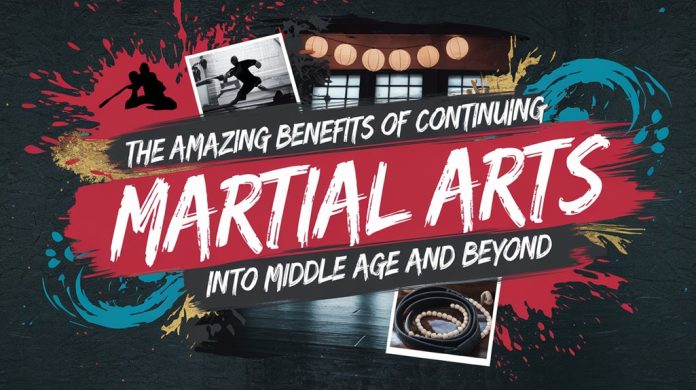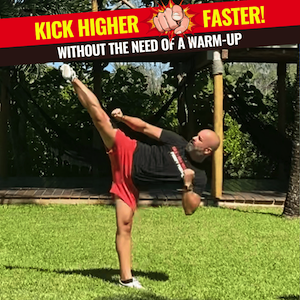You’ll discover incredible rewards from martial arts training as you progress into middle age and beyond. Not only will you build functional strength, balance, and flexibility, but you’ll also sharpen your mental focus and cultivate deep friendships across generations. Your experience and wisdom become invaluable assets, while modified training methods help you stay active and injury-free. There’s a whole world of physical, mental, and social benefits waiting for you on the martial arts path.
Key Points
- Martial arts training enhances joint mobility and bone density while improving balance, reducing fall risks common in middle age and beyond.
- Age-appropriate modifications of techniques allow continued practice while minimizing injury risk and maintaining effectiveness in training.
- Regular practice provides cognitive benefits through complex movement patterns and mindfulness, helping maintain mental sharpness with age.
- Training creates meaningful social connections and mentoring opportunities, fostering a supportive community that spans generations.
- Consistent practice develops both physical and mental resilience, transforming age-related limitations into opportunities for creative adaptation and growth.
Why Age Is Just A Number In Martial Arts Training
Despite what you might’ve heard about martial arts being a young person’s game, the beauty of these ancient disciplines lies in their timeless accessibility.
You’ll find that age inclusivity is a core philosophy in authentic martial arts training, where wisdom and experience often outweigh youthful vigor.
Your journey toward skill mastery isn’t limited by birthdays – it’s fueled by dedication and consistent practice.
Mastery in martial arts flows from your commitment to the path, not the numbers on your birth certificate.
In fact, many practitioners find their technique becomes more refined and efficient as they age, compensating for reduced speed or strength with improved precision and strategy.
You’re not just maintaining physical abilities; you’re developing a deeper understanding of movement, breath control, and mental focus.
Whether you’re 25 or 55, your potential for growth in martial arts remains boundless.
Physical Benefits For The Maturing Body
When you engage in martial arts during your middle years, your body reaps remarkable rewards that go far beyond just staying fit. Through consistent training and dedicated mobility exercises, you’ll discover newfound strength and flexibility that defies aging. Your entire system becomes revitalized as you combine dynamic movements with mindful dietary considerations.
| Benefit | Impact |
|---|---|
| Joint Health | Enhanced flexibility and range of motion |
| Bone Density | Increased strength through resistance training |
| Balance | Improved stability and fall prevention |
| Metabolism | Better weight management and energy levels |
| Recovery | Faster healing and reduced inflammation |
You’re not just maintaining your body – you’re transforming it. Each kick strengthens your core, every stance builds endurance, and all techniques sharpen your coordination. This holistic approach to physical conditioning creates a foundation for vibrant health that serves you well into your golden years.
Mental Sharpness Through Martial Movement
The mental demands of martial arts training create a powerful cognitive workout that keeps your mind razor-sharp through middle age. As you master complex movements and techniques, you’re building neural pathways that enhance cognitive agility and mental focus.
Each session becomes a form of movement meditation, engaging your mind fully in the present moment.
You’ll discover that martial arts training challenges your brain in unique ways – from memorizing sequences to making split-second decisions during sparring. This mental engagement helps protect against age-related cognitive decline while building a stronger mind-body connection.
The discipline required to progress in martial arts also strengthens your mental resilience and problem-solving abilities. You’re not just training your body; you’re developing a sharper, more adaptable mind that serves you in every aspect of life.
Building Unshakeable Balance At Any Age
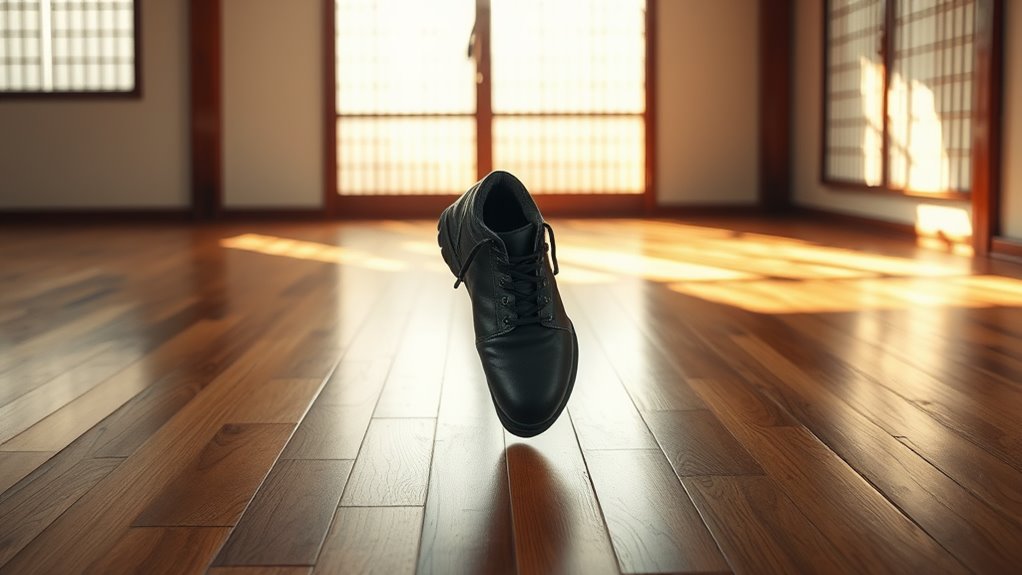
You’ll gain powerful fall prevention skills through dedicated martial arts practice that develops your sense of balance and spatial awareness.
Regular training strengthens your core muscles and improves your ability to maintain stability during everyday movements and unexpected challenges.
When you commit to balance-focused martial arts exercises, you’re investing in lifelong mobility and independence that will serve you well through your middle years and beyond.
Fall Prevention Through Movement
Building unshakeable balance through martial arts creates a powerful defense against one of aging’s biggest threats – dangerous falls. You’ll discover that martial arts training serves as natural movement therapy, dramatically reducing your fall risk through mindful practice and dynamic exercises.
| Movement Type | Fall Prevention Benefit |
|---|---|
| Forward Stance | Strengthens leg stability |
| Side Steps | Improves lateral balance |
| Back Stance | Enhances rear awareness |
| Pivot Turns | Develops rotational control |
You’re not just learning self-defense – you’re building a resilient foundation that keeps you confident and independent. Each kick, stance, and maneuver teaches your body to respond instinctively to unexpected shifts in balance. Through consistent practice, you’ll develop the spatial awareness and quick reflexes needed to catch yourself before a potential fall becomes reality.
Core Stability Training Benefits
Strong core stability forms the foundation of martial arts mastery, working hand-in-hand with your fall prevention skills.
Through dedicated core engagement and functional strength training, you’ll attain a level of balance that transforms your practice and daily life. Your martial arts journey builds a powerhouse core that keeps you stable, confident, and ready for action.
- Master advanced techniques with enhanced core stability that supports every punch, kick, and block
- Build functional strength that translates directly to real-world movements and self-defense scenarios
- Develop unshakeable balance through integrated core engagement exercises specific to martial arts
- Transform your posture and movement quality while reducing risk of back pain and injury
Experience the freedom of movement that comes from a rock-solid core foundation.
Your martial arts practice becomes more dynamic and powerful with every training session, proving that age is truly just a number.
Adapting Training Methods For Older Practitioners
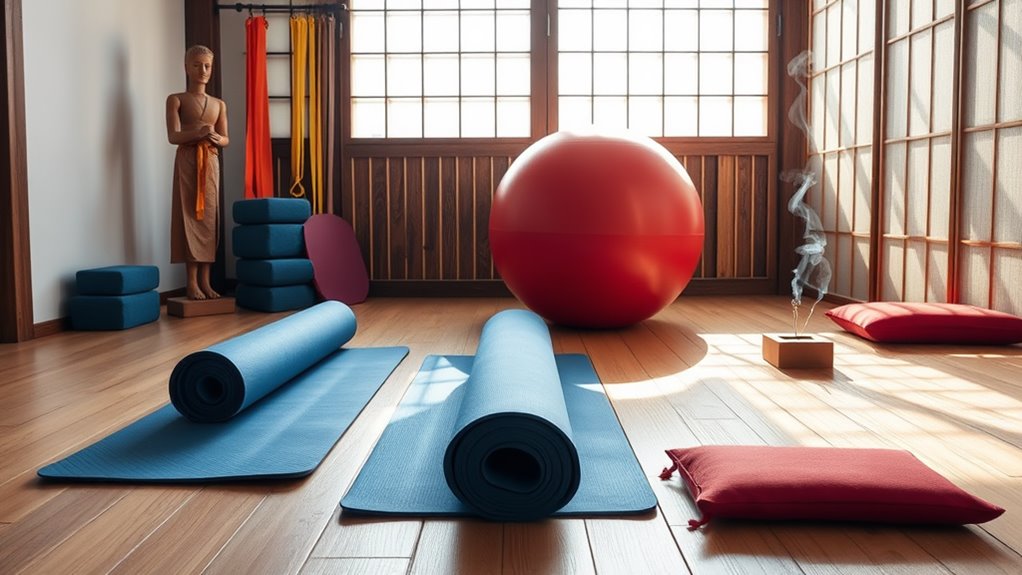
As you continue your martial arts journey into middle age, you’ll need to make smart adjustments to protect your body while maintaining effectiveness.
You can modify high-impact techniques with softer landings and strategic angle changes that reduce stress on your joints.
Modifying Intensity And Impact
When practicing martial arts in your middle years, adapting your training intensity becomes essential for long-term sustainability and injury prevention.
You’ll need to make smart intensity adjustments while maintaining the core principles of your art. Through thoughtful impact modifications, you can continue developing your skills without putting excessive stress on your joints and muscles.
- Replace high-impact jumping techniques with flowing, controlled movements
- Adjust your sparring intensity to focus on technique over power
- Incorporate more form practice and kata work into your training
- Use protective equipment during contact drills to minimize joint stress
Progressive Joint Care Techniques
The health of your joints becomes increasingly essential as you advance in your martial arts journey through middle age.
Embrace joint mobility exercises as your daily ritual, focusing on gentle rotations and controlled movements that maintain flexibility without strain. You’ll discover that mindful preparation prevents unnecessary wear and tear.
Master the art of injury prevention by incorporating dynamic stretching and carefully planned progressions into your training.
Start with slow, deliberate movements before any intense practice, and pay special attention to your knees, hips, and shoulders.
Don’t hesitate to modify traditional techniques – your body’s longevity matters more than rigid adherence to form.
Strengthening Joints And Preventing Injury
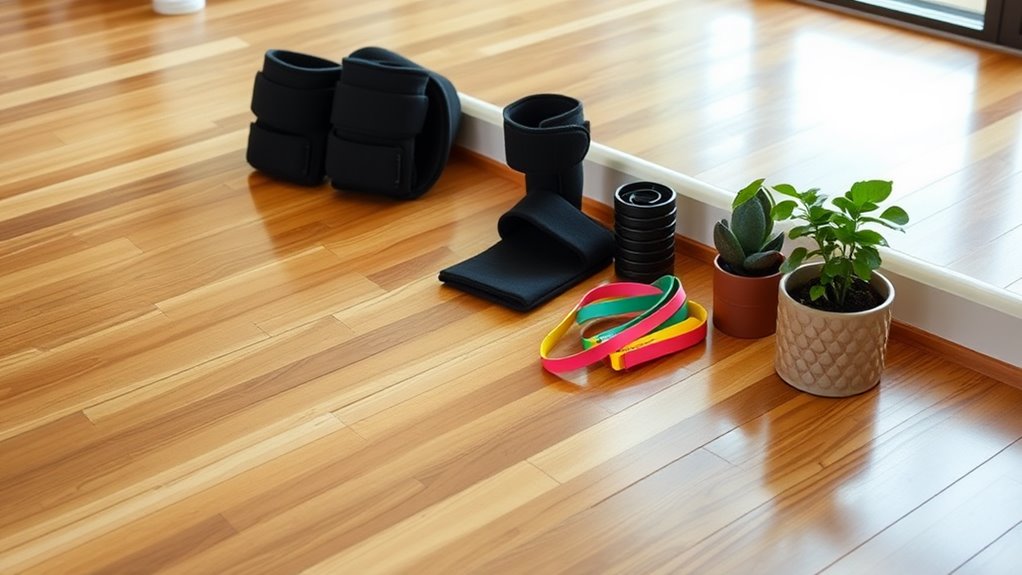
Maintaining healthy joints becomes critically important for martial artists who want to train well into their middle years.
Joint health is the foundation for longevity in martial arts, allowing practitioners to maintain their training intensity as they age.
You’ll discover that focusing on joint mobility exercises and injury prevention techniques helps you move with greater freedom and power.
Take control of your training by implementing smart strategies that protect and strengthen your joints.
- Start each training session with dynamic joint mobility drills targeting ankles, knees, hips, and shoulders.
- Master proper form in all techniques before increasing speed or power.
- Listen to your body and adjust training intensity based on joint feedback.
- Incorporate specific strengthening exercises for commonly stressed areas like wrists and knees.
The Social Aspects Of Training In Later Years
You’ll discover that training martial arts in your middle years creates deep, lasting friendships with peers who share your passion and commitment.
Training alongside younger students lets you mentor while staying humble as a learner, building meaningful bridges across generations.
Making Lifelong Training Partners
Building lifelong training partnerships becomes one of the most rewarding aspects of continuing martial arts into middle age.
You’ll discover that the mats become more than just a training space – they transform into a sanctuary where deep, lifelong bonds are forged through shared experiences, challenges, and victories.
Your friendship circles expand beyond age boundaries as you connect with fellow martial artists who share your dedication and passion.
- Train consistently with partners who match your pace and goals, creating unbreakable bonds through years of practice.
- Share your journey’s ups and downs, supporting each other through injuries and celebrations.
- Build a network of trusted training partners who understand your limitations and strengths.
- Create lasting connections that extend beyond the dojo into everyday life, enriching your martial arts experience.
Building Inter-Generational Connections
As middle-aged martial artists continue their journey, they discover one of the most enriching rewards: meaningful connections across generations. Through shared training experiences, you’ll find yourself learning from both seasoned masters and enthusiastic young practitioners, creating bridges that span decades of martial arts wisdom.
These inter-generational friendships transcend typical age barriers, as you train alongside teenagers, young adults, and fellow mature practitioners. You’ll mentor newcomers while simultaneously gaining fresh perspectives from younger training partners. This dynamic exchange keeps your practice vibrant and your mind open to new possibilities.
The dojo becomes a unique social hub where age dissolves into mutual respect and shared passion. You’ll build lasting bonds through sweat, challenge, and achievement, proving that martial arts truly unite people of all ages in their pursuit of growth.
Supporting Fellow Adult Students
The social bonds formed between adult martial artists create a powerful support system that extends far beyond the training floor.
You’ll find yourself connecting with fellow students who understand your unique journey and shared experiences. Together, you’ll push through challenges, celebrate victories, and grow stronger through peer encouragement.
- Create training partnerships with other adults who match your pace and goals
- Share recovery tips and injury prevention strategies specific to mature bodies
- Build a network of accountability partners who understand your time constraints
- Exchange life wisdom while developing martial skills together
Your fellow adult students become more than training partners – they’re companions on a transformative path.
This supportive community helps you stay committed, overcome obstacles, and maintain your practice through life’s ups and downs.
Together, you’ll redefine what’s possible in your martial arts journey.
Stress Relief And Emotional Well-being
Whether life’s challenges are weighing you down or daily pressures feel overwhelming, martial arts training provides a powerful outlet for stress relief and emotional balance.
Through focused movement and mindfulness practices, you’ll discover a sanctuary where daily worries fade away, replaced by present-moment awareness and inner calm.
As you progress in your martial arts journey, you’ll develop powerful emotional regulation skills that extend far beyond the training floor.
You’ll learn to channel frustration into focused energy, transform anxiety into purposeful action, and build unshakeable mental resilience.
The combination of physical exertion, breathing techniques, and meditative elements creates a holistic approach to stress management that empowers you to face life’s challenges with greater composure and strength.
Take control of your emotional well-being through the transformative power of martial arts.
Self-Defense Confidence For Mature Adults
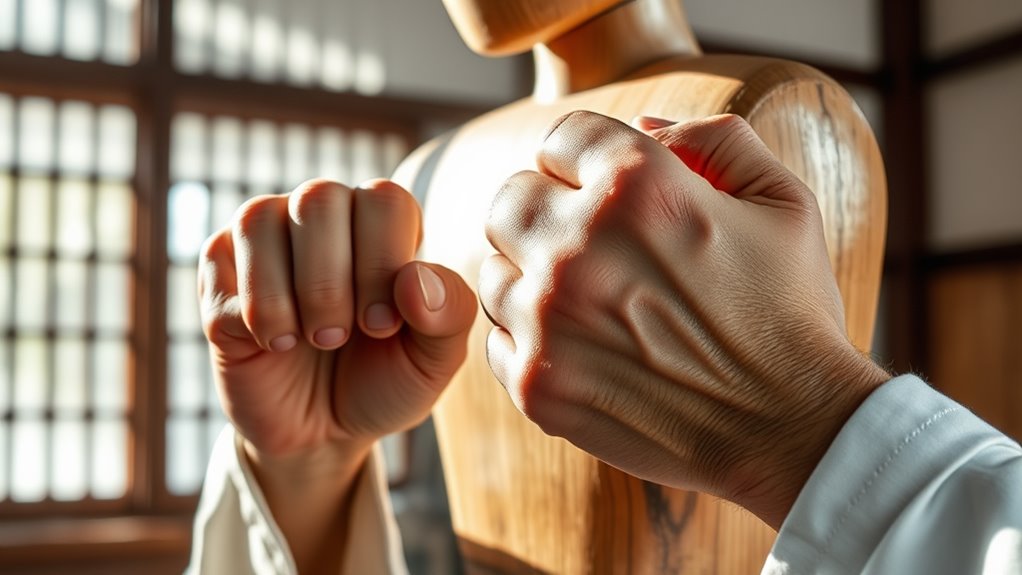
You’ll find that decades of martial arts training have hardwired effective self-defense moves into your muscle memory, making them accessible even as you age.
Through consistent practice, you’re developing a heightened awareness of your surroundings and potential threats, giving you practical safety skills for real-world situations.
Your martial arts journey allows you to adapt and learn age-appropriate techniques that work with your current physical capabilities while maintaining your confidence as a mature practitioner.
Muscle Memory Stays Strong
While aging may slow physical response times, martial artists who continue training well into their 40s and 50s retain remarkable muscle memory from years of practice.
Your dedicated training has embedded efficient movement patterns deep within your nervous system. This enhanced muscle coordination stays with you, allowing you to execute techniques with precision even after periods of inactivity.
- Your body remembers complex movements you’ve practiced thousands of times, letting you respond instinctively in self-defense situations.
- Your movement efficiency remains high because muscle memory doesn’t greatly deteriorate with age.
- You’ll maintain better balance and spatial awareness compared to untrained individuals your age.
- Your trained reflexes will continue to serve you well, even if you’re not as fast as in your younger years.
Stay confident in your abilities – your muscle memory is a powerful ally.
Real-World Safety Awareness
Beyond muscle memory, your martial arts training has given you a heightened sense of awareness that’s invaluable for real-world safety. You’ve developed situational awareness that empowers you to move through life with confidence and control. Your self defense strategies have become second nature, allowing you to anticipate and avoid potential threats before they materialize.
| Awareness Level | Real-World Application |
|---|---|
| Environmental | Scanning exits and entry points |
| Physical | Maintaining ideal distance |
| Social | Reading body language cues |
| Emotional | Trusting your instincts |
| Mental | Strategic decision-making |
You’re not just practicing techniques; you’re cultivating a warrior’s mindset that serves you in every aspect of life. This heightened awareness becomes your invisible shield, protecting you while traversing both familiar and unfamiliar environments with unwavering confidence.
Age-Appropriate Defense Techniques
As mature martial artists adapt their training, mastering age-appropriate defense techniques becomes essential for long-term sustainability and effectiveness.
You’ll discover that smart self defense tactics rely more on wisdom than raw power. By combining your experience with situational awareness, you’ll develop a more refined approach to personal protection that serves you well through the years.
- Master leverage-based techniques that use an attacker’s momentum against them
- Focus on efficient movement patterns that conserve your energy while maximizing impact
- Develop quick-strike methods targeting vulnerable areas requiring minimal force
- Practice defensive footwork that keeps you balanced and creates escape opportunities
Embrace these adaptations with confidence – they’re not compromises but evolutionary improvements to your martial arts journey.
Your mature approach to self-defense becomes more sophisticated and practical with each passing year.
Finding The Right Martial Art Style For Your Age
Selecting the right martial art during your middle years requires careful consideration of your physical capabilities and personal goals.
Choosing a martial art in midlife means matching your body’s abilities with your aspirations for personal growth and physical development.
You’ll want to explore age-specific styles that align with your current fitness level while challenging you to grow stronger. Consider martial arts like Tai Chi, which emphasizes balance and controlled movements, or Aikido, which focuses on redirecting energy rather than forceful strikes.
Your personal fitness journey should guide your choice. If you’re already athletic, you might embrace more dynamic styles like Karate or Wing Chun.
If you’re just starting out, look for schools that offer modified training programs specifically designed for mature practitioners.
Cross-Training Benefits With Other Activities
You’ll activate powerful training synergies by combining your martial arts practice with complementary activities like swimming, yoga, or cycling.
Your cardiovascular endurance will soar to new heights as you blend different movement patterns and energy systems across multiple disciplines.
The varied cross-training motions will dramatically improve your flexibility and body awareness, helping you execute martial arts techniques with greater precision and control.
Enhances Cardio Performance Gains
While many people believe martial arts automatically improve cardio fitness for other sports, research doesn’t support this assumption.
To maximize your cardio adaptations across activities, you’ll need a strategic approach to endurance training that complements your martial arts practice.
Here’s how to boost your overall cardiovascular performance:
- Alternate between high-intensity martial arts drills and steady-state cardio workouts.
- Track your heart rate during different activities to verify you’re hitting ideal training zones.
- Schedule recovery periods that allow adaptation without overtraining.
- Gradually increase training volume across both martial arts and cardio sessions.
Builds Multi-Movement Flexibility
Martial arts training creates remarkable flexibility benefits, but these don’t automatically transfer to other sports or activities. You’ll need to consciously apply your martial arts movements to enhance performance in other physical pursuits.
Through dynamic stretching and systematic training, you’ll develop a unique type of adaptable flexibility that serves you well beyond the dojo. Your improved coordination will positively impact everything from golf swings to tennis serves.
You’ll notice enhanced range of motion in your hips, shoulders, and spine that makes daily activities feel more fluid and natural. Liberation comes from breaking free of movement restrictions.
Creating A Sustainable Practice Routine
When establishing a long-term commitment to martial arts training, creating a sustainable practice routine becomes essential for success.
You’ll need to design a schedule that fits seamlessly into your life while remaining flexible enough to adapt as circumstances change.
By focusing on sustainable scheduling and routine adaptability, you can maintain your practice without burning out or feeling overwhelmed.
- Start with 2-3 weekly sessions and gradually increase based on your energy levels
- Schedule your training at consistent times when you’re naturally most energetic
- Build in recovery days to prevent injury and maintain motivation
- Create mini-practice sessions for busy days to keep momentum going
Recovery Strategies For Older Martial Artists
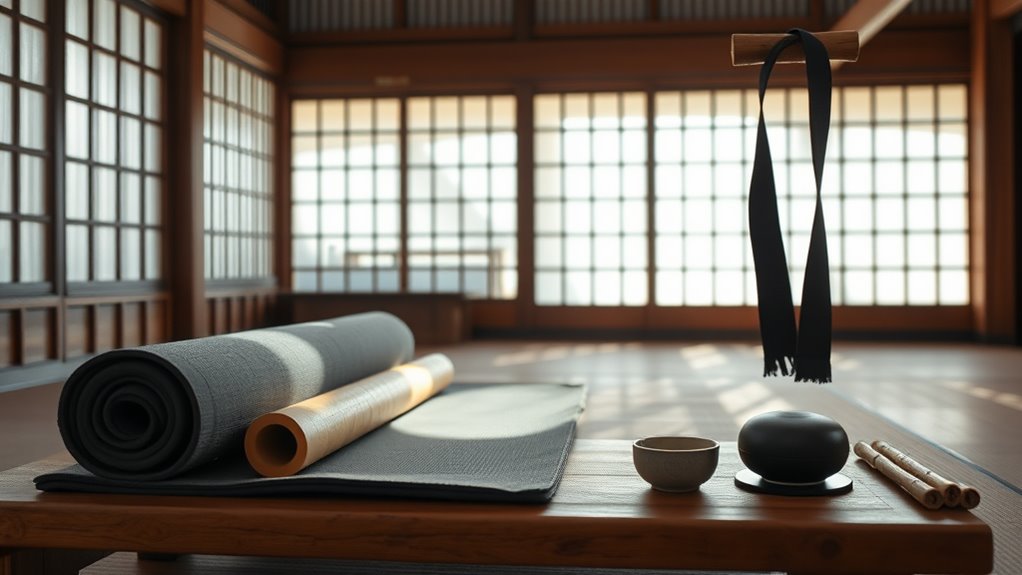
As your body ages, proper recovery becomes the cornerstone of maintaining an active martial arts practice. You’ll need smart recovery techniques to stay strong and prevent injuries that could derail your progress. Embrace these proven strategies to keep your martial spirit thriving.
| Recovery Method | Benefits | Frequency |
|---|---|---|
| Contrast Therapy | Reduces inflammation | 2-3x weekly |
| Dynamic Stretching | Maintains flexibility | Daily |
| Active Rest | Promotes healing | As needed |
Listen to your body’s signals and adjust your training intensity accordingly. Ice therapy after intense sessions, gentle movement on rest days, and proper sleep will accelerate your recovery. Don’t let age define your limits – with the right injury prevention approach, you’ll continue growing stronger and more skilled in your martial arts journey.
Building Core Strength And Stability
Strong core muscles serve as the foundation for every technique in martial arts, from powerful kicks to lightning-fast strikes.
A powerful core anchors every martial arts movement, unleashing explosive force and precision from the center of your being.
That’s why core training must become your daily ritual, empowering you to maintain balance and generate explosive power.
Through targeted stability exercises, you’ll build a resilient center that protects your spine and enhances every movement.
- Integrate dynamic planks into your warmup routine to activate deep core muscles and improve posture.
- Practice traditional martial arts stances while engaging your core to build functional strength.
- Use medicine ball rotations to develop powerful twisting movements for strikes.
- Combine breathing techniques with core exercises to maximize energy flow and stability.
Your strong core is your secret weapon – embrace these exercises to release your full martial arts potential.
Maintaining Flexibility Through The Years
Maintaining flexibility becomes increasingly essential as your body naturally stiffens with age. Through martial arts training, you’ll discover powerful ways to keep your joints supple and muscles pliable.
Start each session with dynamic stretching to warm up your body and protect against injury. You’re not just fighting physical limitations – you’re breaking free from the constraints that time tries to impose on your movement.
Incorporate gentle yoga techniques between training sessions to deepen your flexibility and maintain the gains you’ve made. Listen to your body’s signals while pushing past comfort zones.
You’ll be amazed at how your range of motion improves when you stay consistent with these practices. The key is to make flexibility training a non-negotiable part of your martial arts journey.
The Role Of Breath Work And Meditation
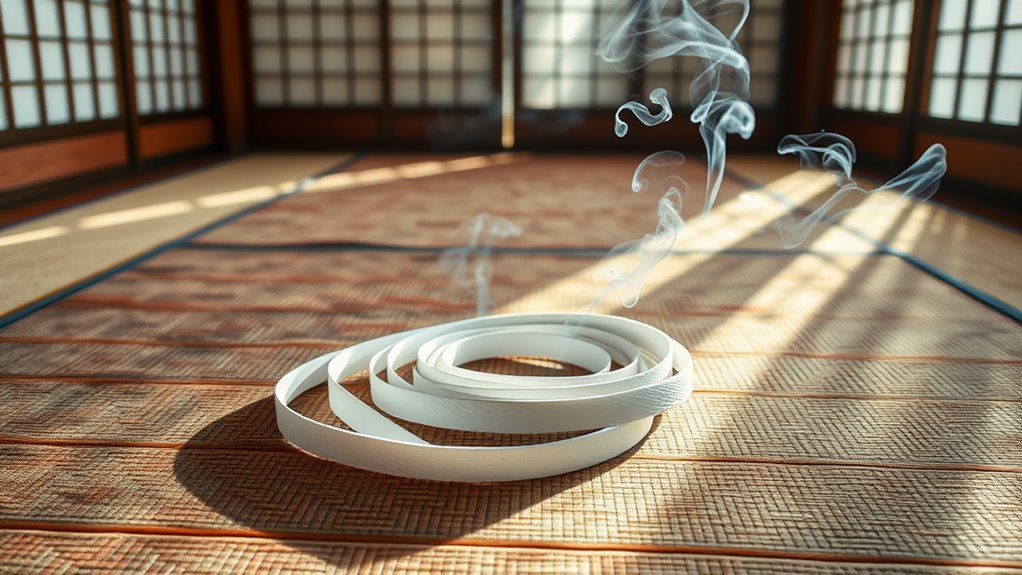
While martial arts demands physical prowess, mastering your breath and mind creates a powerful foundation for your practice. Through dedicated breath control and mindfulness practice, you’ll access deeper levels of focus, power, and inner peace.
Your martial arts journey becomes more profound as you integrate these ancient wisdom traditions into your training.
- Learn to harness your breath during forms and sparring to amplify your techniques and maintain composure.
- Develop razor-sharp focus through meditation that carries over into every aspect of training.
- Release tension and mental blocks that hold back your progress through mindful breathing.
- Transform your practice into moving meditation, connecting mind, body, and spirit.
You’ll discover that breath work and meditation aren’t just supplementary skills – they’re essential tools that elevate your martial arts mastery to new heights.
Modifying Techniques For Limited Mobility
As our bodies change with age, adapting your martial arts practice becomes both an art and a necessity. You don’t have to give up your passion – instead, embrace adaptive techniques that work with your current capabilities.
Transform high kicks into effective mid-level strikes, and modify joint locks to require less flexibility while maintaining their effectiveness.
Gentle sparring allows you to maintain your combat skills without risking injury. Work with experienced instructors to develop variations of traditional moves that protect your joints and spine.
Developing Mental Resilience With Age
Beyond the physical aspects of martial arts, your mental game becomes increasingly essential as you age. Your mental fortitude grows stronger through consistent training, enabling you to face life’s challenges with unwavering confidence.
Embrace age adaptability as you discover new ways to overcome obstacles both on and off the mat.
- Challenge your mind by learning complex techniques that require strategic thinking and precise execution.
- Build resilience through practicing difficult moves until you master them, regardless of how long it takes.
- Develop razor-sharp focus that transfers to every aspect of your daily life.
- Transform age-related limitations into opportunities for mental growth and creative problem-solving.
You’re not just maintaining your skills – you’re evolving into a more complete martial artist who understands that true strength starts in the mind.
Teaching And Mentoring Opportunities
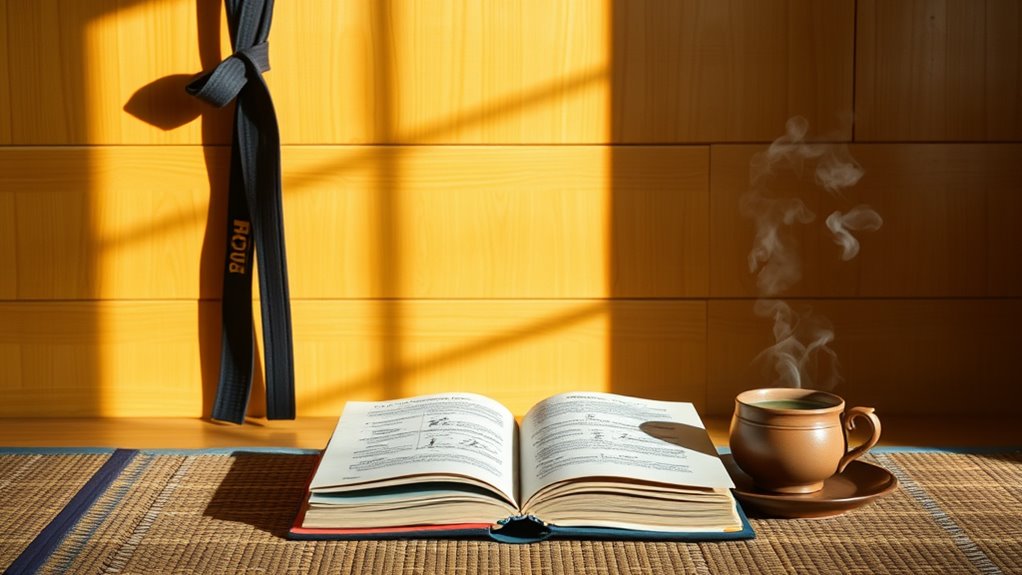
Teaching martial arts offers one of the most rewarding ways to deepen your practice while giving back to the community. As you advance in your martial arts journey, you’ll discover opportunities to mentor others, especially youth who are just beginning their path.
By sharing your knowledge and experience, you’re not only helping others grow but also reinforcing your own skills and understanding.
When you’re mentoring youth, you’ll find yourself fostering discipline in ways that transform both student and teacher. You’ll develop new perspectives on techniques you’ve practiced for years, and you’ll learn to break down complex movements into teachable components.
This process of teaching others will challenge you to evolve your communication skills and deepen your own practice, creating a meaningful legacy within your martial arts community.
Long-term Health Benefits Of Martial Arts
Regular martial arts practice delivers profound health benefits that extend well into your middle age and beyond.
Through mindful martial arts adaptations, you’ll discover renewed energy and increased mobility that supports aging gracefully. Your journey becomes a powerful path to lifelong wellness, strengthening both body and mind.
- You’ll build functional strength and flexibility that protects your joints and spine, reducing age-related stiffness.
- Your balance and coordination will considerably improve, decreasing fall risks and maintaining independence.
- The meditative aspects enhance mental clarity and memory while reducing stress and anxiety.
- You’ll boost cardiovascular health and maintain healthy bone density through dynamic, full-body movements.
Embrace this transformative practice that empowers you to take control of your health destiny and thrive in your mature years.


